Planning how to visit Machu Picchu can feel overwhelming with its strict rules and ticket limits. This ancient Inca city sits high in the Andes Mountains at 7,972 feet above sea level.
Our step-by-step guide will help you plan your 2025 trip to this UNESCO site with clear tips about tickets, transport, and trails. Get ready to explore Peru’s most famous ruins like a pro.
Key Takeaways
Book Machu Picchu tickets at least 3 months ahead through the official website, with adult tickets costing $42 and student tickets $20 in 2025.
The best time to visit is May through September, with July and August being peak months. The site opens daily from 6 AM to 2 PM with nine entry slots.
Getting there requires a train ride from Cusco to Aguas Calientes (3.5 hours, $55-70 one way), followed by a 25-minute bus ride up to the ruins ($24 round trip).
Visitors can choose from several hiking trails, including the famous 4-day Classic Inca Trail (limited to 500 people daily) and the challenging Salkantay Trek (45 miles over 5 days).
Stay in either Aguas Calientes (closest to ruins) or Cusco (main tourist hub), with options ranging from budget hostels to luxury hotels like the Belmond Sanctuary Lodge right at the site entrance.
Table of Contents
Best Time to Visit Machu Picchu
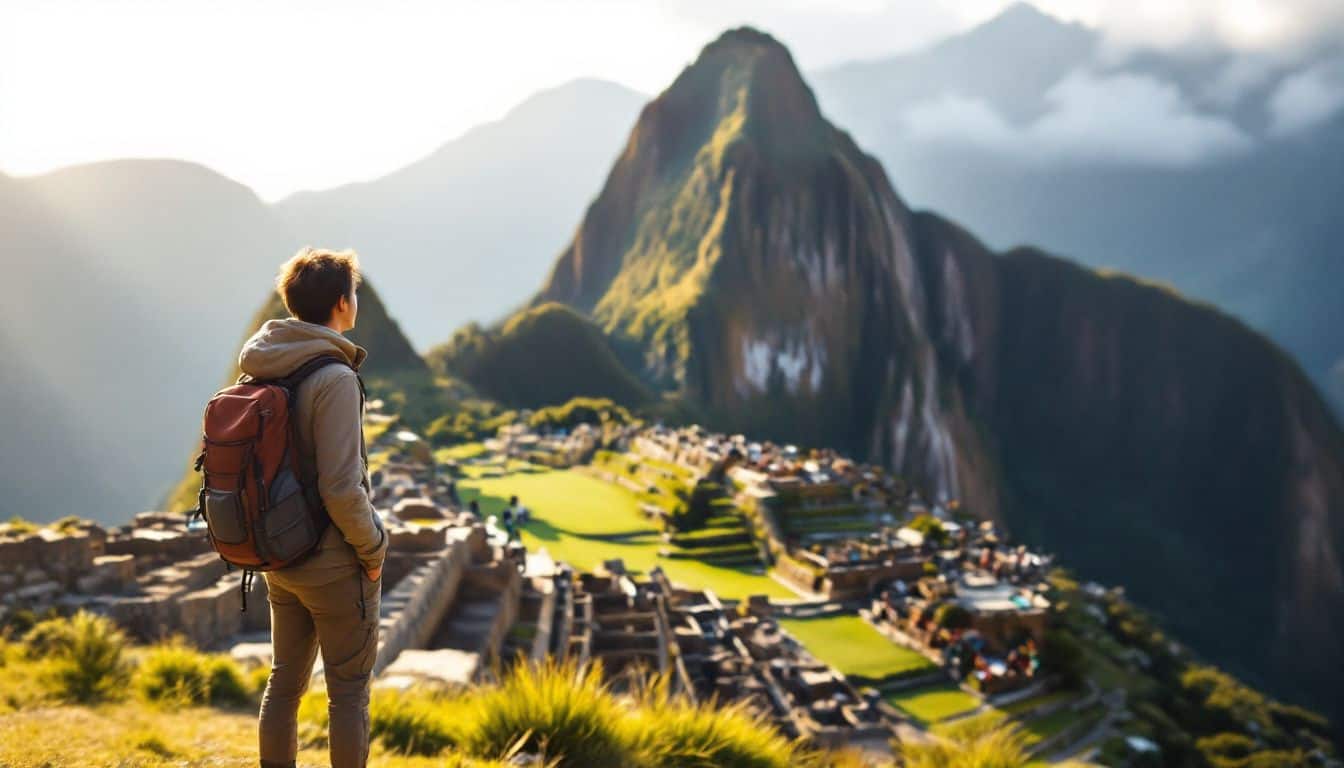
The perfect time to explore Machu Picchu falls between early May and late September. According to GuruExplorers, July and August draw the largest crowds, with Sundays being extra busy.
The dry season offers clear skies and stable weather for hiking the Inca Trail or climbing Huayna Picchu.
Machu Picchu reveals its true magic in the afternoon light, when most tourists have left. – Local Andean Guide
October through April brings frequent rain to the Sacred Valley. Smart travelers pick early May or late September to dodge peak crowds and rain. The site opens daily with nine entry slots from 6 AM to 2 PM.
Afternoon visits offer a quieter experience at this Incan marvel, perfect for taking in the Temple of the Sun without shoulder-to-shoulder crowds.
How to Get to Machu Picchu
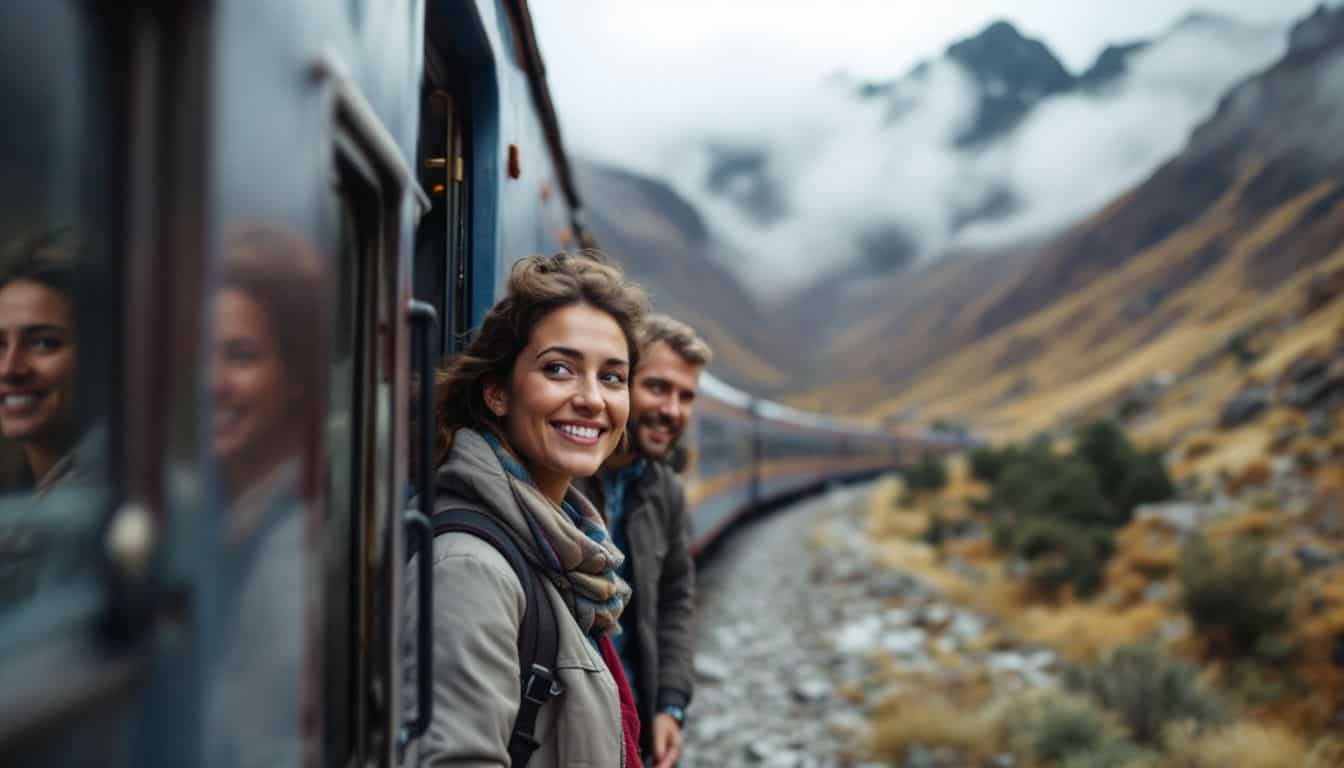
Getting to Machu Picchu needs a mix of transport options through the Andes. You can start your trip from Cusco to Aguas Calientes by train on PeruRail or Inca Rail, then catch a bus up the winding mountain road to the ancient site.
Traveling from Cusco
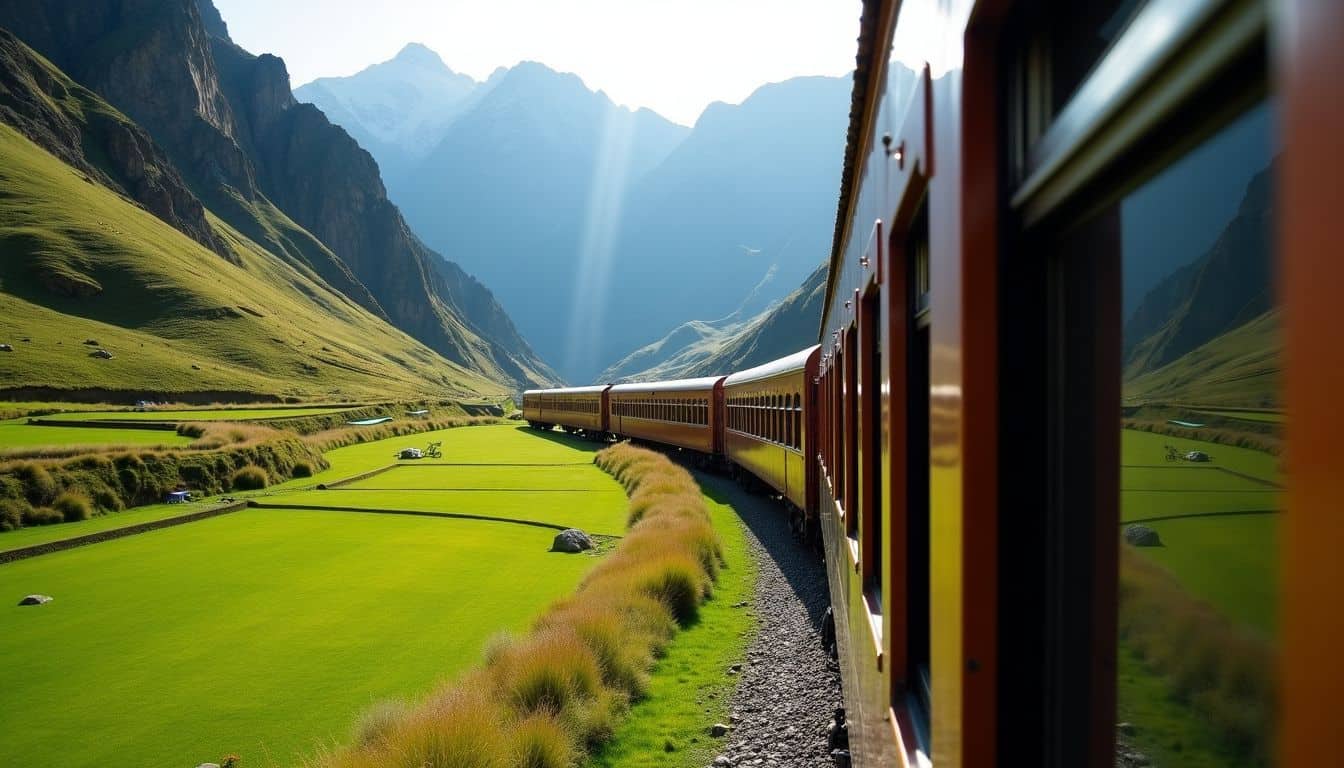
Your trip to Machu Picchu starts in Cusco, Peru’s ancient Incan capital. Most visitors land at Alejandro Velasco Astete International Airport, sitting at 11,000 feet above sea level.
The high altitude hits hard, so smart travelers stay in Cusco for two or three days first. The city offers perfect spots to rest, like the historic San Blas district, with its narrow cobblestone streets and local craft shops.
The path from Cusco to Machu Picchu runs through the Sacred Valley of the Incas. You’ll need to reach Aguas Calientes, the gateway town to the ruins. Peru Rail and Inca Rail offer daily trains from Cusco’s Poroy station, taking about 3.5 hours through stunning Andean landscapes.
The trains range from basic to luxury, like the fancy Belmond Hiram Bingham with its dining cars and observation decks. Many guys pick the mid-range Vistadome train for its big windows and solid value.
Taking the Train
Trains offer the most scenic route to Machu Picchu through the Sacred Valley. Three rail companies run daily trips: Inca Rail, Peru Rail, and the fancy Belmond Hiram Bingham train.
The ride from Cusco’s Poroy station to Aguas Calientes takes about 3.5 hours. Basic tickets cost between $55 to $70 each way, with better deals during off-peak months at around $10 less.
The trains zip along the Urubamba River, past snow-capped peaks and ancient Incan roads. Large windows give clear views of Andean villages and steep mountain slopes. Most trains leave early morning and return late afternoon.
Smart travelers book seats on the left side going to Machu Picchu for the best views. The bus ride up to the ruins starts right after you reach Aguas Calientes.
Taking the Bus
Buses offer the fastest way to reach Machu Picchu from Aguas Calientes. Consettur runs shuttle buses every 10–15 minutes, making the trip up the mountain quick and easy. The ride takes about 25–30 minutes each way through several switchbacks.
Your round-trip bus ticket costs $24, which saves time and energy for exploring the Incan ruins.
The first buses start running at dawn, perfect for catching the sunrise at the Sun Gate. Buses drop visitors off right at the main entrance to Machu Picchu. Lines can get long during peak season, so grab your spot early.
The buses are safe, clean, and run on a clear schedule all day long.
Hiking Options
Machu Picchu offers several hiking paths for every fitness level. Each trail leads to stunning views of the ancient Incan ruins.
- The Classic Inca Trail spans 43 kilometers over 4 days. You must book permits months ahead since only 500 people can hike daily.
- KM104 trail fits busy schedules perfectly. This 12-kilometer trek takes 6-7 hours and shows off amazing mountain views.
- Salkantay Trek provides a less crowded option to reach Machu Picchu. The path runs through snowy peaks and thick jungle areas.
- Lares Trek shows real Andean life up close. Local villages and hot springs dot this three-day path through the mountains.
- Choquequirao Trek takes you to the “Sacred Sister” site of Machu Picchu. This tough eight-day hike rewards you with quiet trails and rare views.
- The Sun Gate (Inti Punku) hike starts inside Machu Picchu. This short uphill walk takes about 45 minutes each way.
- The Inca Bridge trail offers a quick but thrilling walk. The narrow path hangs on cliff edges with old Incan engineering on display.
The train station at Aguas Calientes serves as your gateway to these amazing trails.
Here are options for accommodation during your Machu Picchu visit.
Popular Trekking Routes
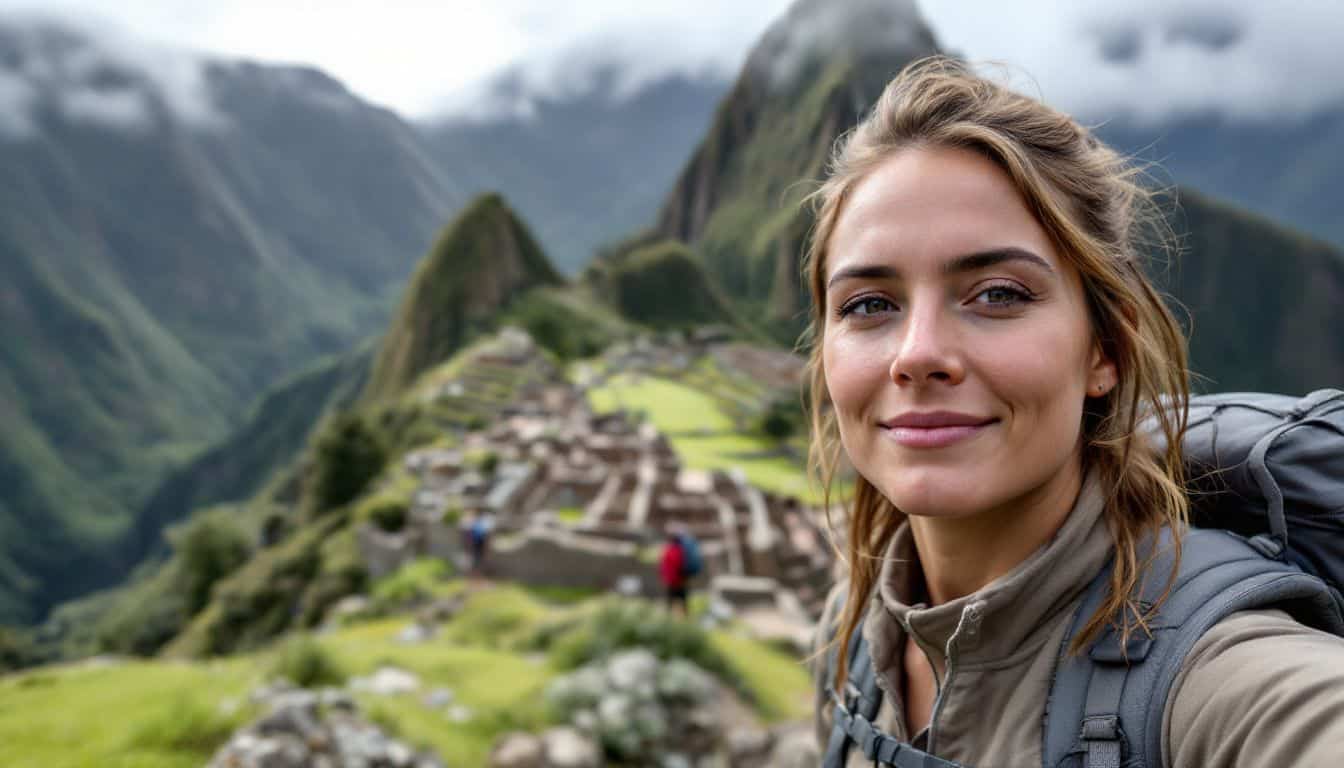
Machu Picchu offers several amazing hiking trails that lead to its ancient stone walls. Each trek takes you through stunning mountain passes, past remote villages, and gives you a deep look into Peru’s rich history.
Classic Inca Trail
The Classic Inca Trail stands as Peru’s most famous trek to reach the ancient ruins. This 43-kilometer path takes hikers through stunning Andean landscapes and past several Incan ruins.
The trail limits daily visitors to 500 people, which includes guides and porters. Permits sell fast, often months ahead of time.
The Inca Trail teaches you to respect the mountains and the ancient paths that connect them. – Local Guide
The four-day trek leads travelers through high mountain passes and cloud forests to reach Machu Picchu. Hikers pass through three major Inca sites before reaching the final destination.
The trail closes each February for vital maintenance work. Most trekkers start from Cusco or Ollantaytambo, staying at designated campsites along the route. The path demands good fitness and proper altitude acclimatization for success.
Salkantay Trek
Beyond the Classic Inca Trail lies a more challenging path to Machu Picchu – the Salkantay Trek. This tough trail reaches 20,569 feet at its highest point, making it one of Peru’s most thrilling hikes.
Trekkers spend five days covering 45 miles through varied Andean landscapes. Mountain views, glacial lakes, and cloud forests fill each day’s route.
Hikers pass through remote Andean villages and camp under star-filled skies during this trek. Most guides lead small groups of 8–12 people to limit environmental impact. Smart packers bring warm layers for cold nights at high camps.
Proper acclimatizing in Cusco helps prevent altitude problems on this demanding route.
Lares Trek
Unlike the busy Salkantay Trek, the Lares Trek offers a peaceful path through local Andean communities. This lesser-known route starts in the Sacred Valley and winds through stunning mountain passes at high altitudes.
The trail passes by hot springs, pristine lakes, and small villages where locals still wear traditional dress and weave colorful textiles.
The trek covers about 22 miles over three days, making it shorter than the classic four-day Inca Trail. Hikers pass through remote Peruvian settlements and meet native alpaca herders along the way.
The trail ends in Machu Picchu Pueblo, where trekkers can rest before visiting the ancient citadel. Most tour operators charge between $600-$800 for this trek, which includes meals, camping gear, and guides who speak both Spanish and English.
Choquequirao Trek
The Choquequirao Trek stands as a tough but rewarding path through Peru’s Andean foothills. This 62-mile trek takes hikers through remote mountain passes and ancient Incan ruins over 4-5 days.
The trail starts at Capuliyoc at 2,915 meters and ends at Machu Picchu at 2,430 meters. Most hikers spend their nights at basic campsites along the route, carrying their own gear and supplies.
The Choquequirao Trek reveals Peru’s best-kept secret – a path less traveled to greatness. – Local Guide Carlos Mendoza
The trek offers close views of snow-capped peaks and chances to spot Andean condors soaring overhead. Hikers pass through varied zones, from high-altitude grasslands to cloud forests rich with orchids.
The route connects two major Incan sites – the remote ruins of Choquequirao and the famous Machu Picchu. The path demands good fitness levels as it includes steep climbs and descents.
Proper planning helps deal with the altitude changes and weather shifts common in this part of South America.
How to Purchase Tickets
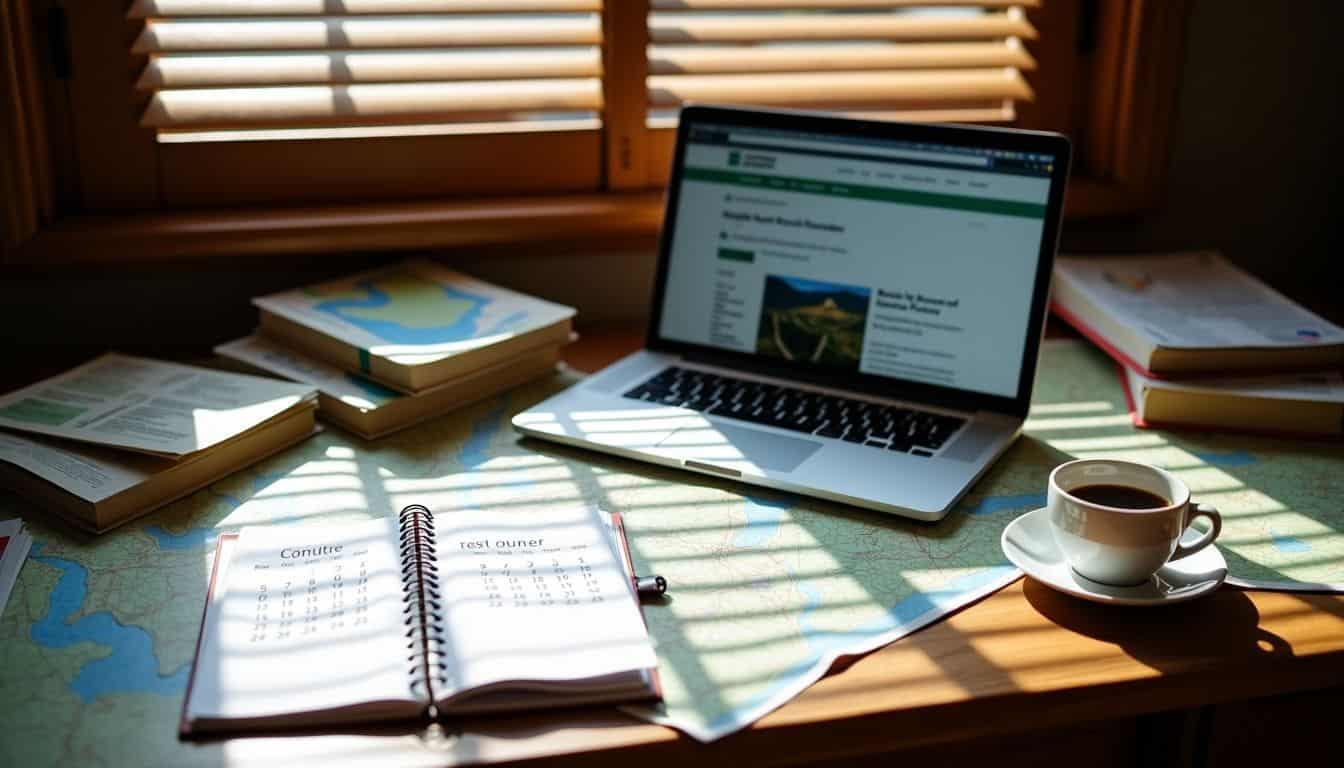
Buying tickets for Machu Picchu needs careful planning – you’ll want to grab your entry passes, mountain hikes, and train tickets at least three months before your trip… Ready to learn the exact steps to secure your spot at this amazing Incan site?
Entry Tickets for Machu Picchu
Machu Picchu tickets cost $42 for adults and $20 for students in 2025. The sacred Incan site limits daily visitors to 5,600 people during peak season to protect its ancient structures.
Tourists must grab their spots fast, since tickets go on sale starting December 19, 2024.
Getting tickets takes just a few steps through the official Peruvian government website. Smart travelers book at least three months ahead to secure their preferred dates. The site accepts major credit cards and sends digital confirmations right to your email.
You’ll need your passport details handy during booking.
Tickets for Huayna Picchu and Machu Picchu Mountain
Huayna Picchu tickets sell out fast, with only 200 spots open each day. You must be 18 or older to climb this steep peak. The entrance fee costs S/200 ($53) per person. Smart travelers book these tickets months ahead through the official website or trusted tour groups.
The views from both peaks offer perfect spots for photos of the ancient Incan ruins below.
The sacred rock formations give you two main climbing options. Huayna Picchu stands tall at the north end, while Machu Picchu Mountain rises from the south. Both trails need strong legs and good lungs due to the high altitude.
Your next step involves picking the right place to stay near these amazing peaks.
Train Tickets
After securing your mountain climb permits, you’ll need train tickets to reach Machu Picchu. Peru Rail and Inca Rail offer daily trips to Aguas Calientes from Cusco. Train tickets cost between $140 to $950 for a round trip.
Both companies run modern trains with big windows to see the Andean views. The prices change based on the service level and time of day you pick.
Book your train seats at least 2–3 months before your trip dates. The trains fill up fast, especially during peak tourist months. Most trains leave from Poroy station near Cusco or Ollantaytambo in the Sacred Valley.
The ride takes about 3 to 4 hours through stunning mountain passes. Each train offers comfy seats, snacks, and drinks for sale during the trip.
Booking Through a Tour Operator
Tour operators make Machu Picchu trips simple and stress-free. Many travelers pick the Sacred Valley with Extended Machu Picchu package at $3,390 for a week-long adventure. This package includes train tickets, entry permits, and expert guides who know the best spots for photos.
I booked through an official vendor last summer and loved how they handled all the details, from Cusco hotel bookings to Inca Trail permits.
Local tour companies offer great deals for guys seeking thrilling adventures in Peru. Your tour guide takes care of passport checks, ticket purchases, and altitude tips.
Most packages include visits to key spots like the Temple of the Condor and Intipunku. The guides also share cool facts about the Incan Empire and Andean culture that you won’t find in guidebooks.
Accommodation Options
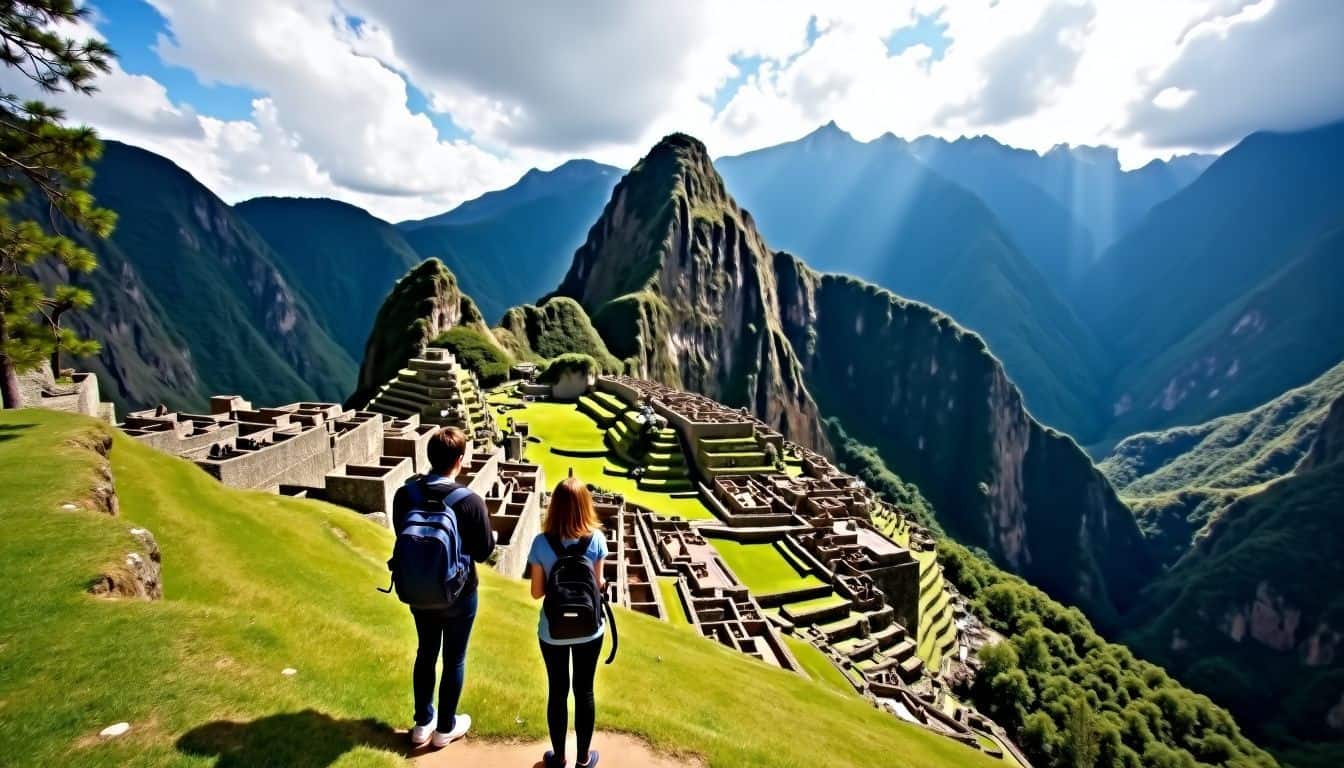
Machu Picchu offers a range of places to stay that fit every budget – from basic hostels to five-star resorts. You’ll find cozy spots in Aguas Calientes that put you minutes away from the ancient ruins, while Cusco’s hotels blend local Peruvian culture with modern comforts.
Where to Stay in Aguas Calientes
Aguas Calientes offers several great places to rest your head before your Machu Picchu visit. The Belmond Sanctuary Lodge stands as the only hotel right next to the ancient site. This prime spot lets you beat the morning crowds and enjoy extra time at the ruins.
The town also features the luxurious Inkaterra Machu Picchu Pueblo Hotel, which sits in a peaceful cloud forest setting. The Sumaq Machu Picchu Hotel brings top-notch service with stunning river views.
Most hotels in Aguas Calientes lie within walking distance to the bus station and local restaurants. Budget travelers can find clean, basic rooms at many family-run guesthouses near the main square.
The best rooms face the rushing Urubamba River or the surrounding mountains. Your next major choice involves picking the right spot to eat in this bustling tourist town.
Where to Stay in Cusco
Cusco offers places to stay for every budget and style. The JW Marriott El Convento stands out as a top luxury pick in the city center. This five-star hotel mixes old-world charm with modern comforts.
The Palacio del Inka also brings royal treatment with its prime spot near the main square. Both hotels help guests deal with altitude sickness through oxygen-enriched rooms.
Budget travelers will love Casa Inkusko and Antarki Guest House. These spots give you clean rooms and friendly service without breaking the bank. Most budget hotels sit in the San Blas area, known for its art shops and cafés.
The San Pedro Market area also has good cheap stays, perfect for exploring local Peruvian cuisine. Each neighborhood brings its own flavor to your Cusco trip.
Luxury Hotels and Resorts Near Machu Picchu
Machu Picchu offers top-tier hotels that blend comfort with stunning mountain views. The Belmond Sanctuary Lodge stands out with its 32 exclusive rooms right at the entrance of the ancient citadel.
This prime spot lets guests explore the ruins before other tourists arrive. The lodge serves gourmet meals and provides spa treatments after long hikes.
Luxury stays extend beyond the citadel to nearby areas. The Tambo del Inka resort features a private train station for direct trips to Machu Picchu. Guests can sip authentic Pisco Sours at the Palacio del Inka’s special cocktail-making classes.
These high-end hotels mix Andean culture with modern luxury through local art, native materials, and regional cuisine.
Dining Options

Savor local Peruvian flavors at top-rated spots in Aguas Calientes and Cusco, where chefs blend ancient Incan recipes with modern cooking styles – keep reading to discover our favorite restaurants that serve up authentic dishes near Machu Picchu.
Best Restaurants in Aguas Calientes
Aguas Calientes offers top-notch dining spots that blend local flavors with international flair. Tampu Restaurant at Sanctuary Lodge stands out with its premium Peruvian dishes and expert chefs who create magic on your plate.
The restaurant’s location near Machu Picchu gives you stunning views while you eat.
Food lovers must try Indio Feliz for its unique French-Peruvian fusion menu that packs bold tastes into every bite. Tree House Restaurant brings fresh, organic ingredients to life through traditional cooking methods.
These spots serve more than just food – they offer a taste of Peru’s rich culinary heritage right at the base of the ancient Incan city.
Where to Eat in Cusco
Cusco offers amazing food spots for every taste and budget. Incanto stands out as a top choice for its perfect blend of local and international dishes. The Inka Grill serves up tasty traditional plates in a cozy setting.
Morena Peruvian Kitchen brings modern twists to classic Andean recipes. These spots give you a real taste of Peru’s rich food culture.
San Pedro Market brings the true spirit of local dining to life. You’ll find the best Chiriuchu Cusqueño here – a mix of guinea pig, corn, and spices that locals love. The market also serves hot Rocoto Relleno Cusqueño, a stuffed pepper dish that packs some heat.
The food stalls buzz with energy, and the prices stay low. The market opens early and closes late, making it perfect for grabbing breakfast or a late lunch after exploring the city.
Key Activities at Machu Picchu
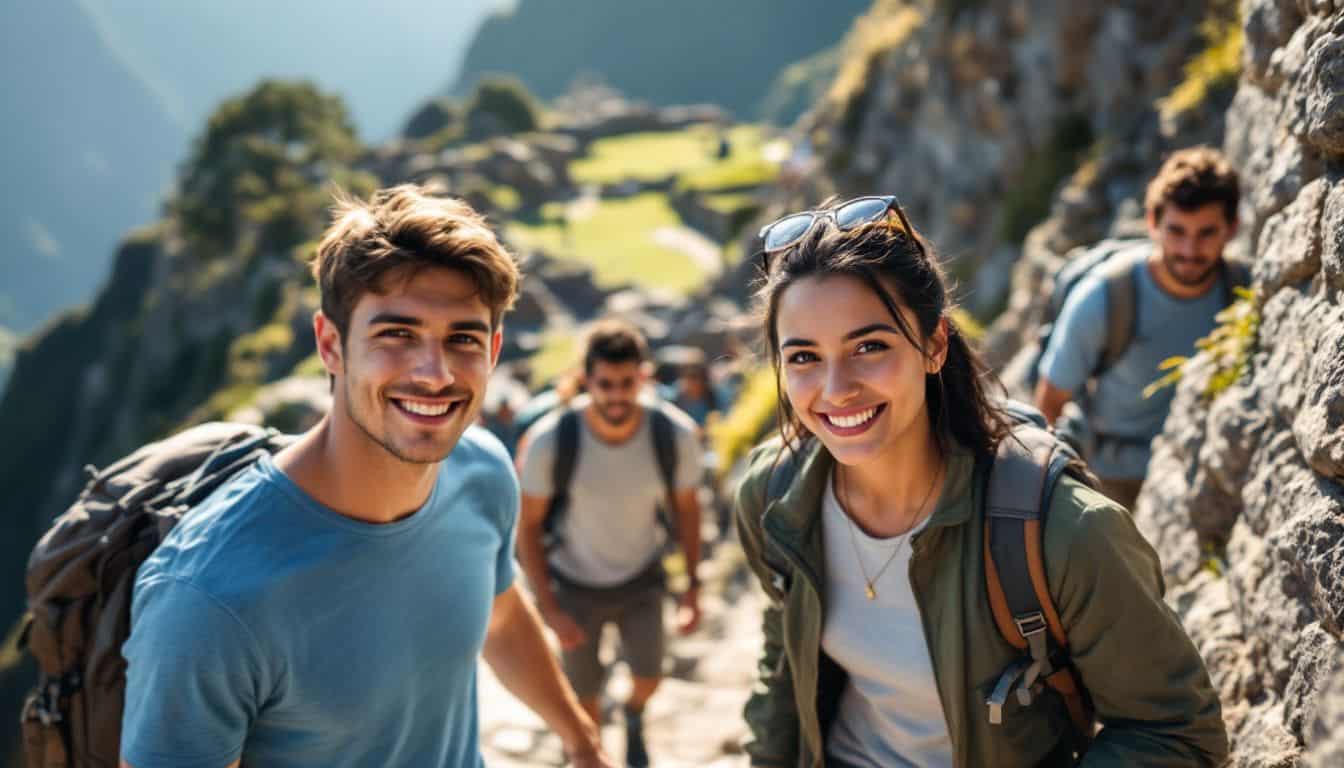
Machu Picchu offers thrilling activities, from climbing the ancient stone steps to watching the sunrise at the Sun Gate – grab your hiking boots and read on to discover the most exciting spots at this Incan marvel.
Exploring the Main Ruins
The Sacred Stone stands as a key highlight within the main ruins. You’ll spot this masterpiece of Incan engineering right next to the Temple of the Sun. Our guide pointed out the precise stone cuts and perfect angles that showcase ancient building skills.
The ruins stretch across multiple levels, each telling its own story of daily life in this mountain citadel.
Local guides lead all tours through the main complex, sharing deep insights about the Andean people. The Temple of the Sun displays some of the finest stonework in all of Cusco, Peru.
Its walls align perfectly with the summer solstice – a testament to Incan astronomical knowledge. Visitors must stick to marked paths to protect these ancient structures from damage.
The site limits daily visitors, so booking ahead helps secure your spot to explore these remarkable ruins.
Hiking to Inti Punku (Sun Gate)
The Sun Gate sits high above Machu Picchu, offering the most stunning views of the ancient city. Hikers start this trek from the main ruins, following a well-marked path that climbs steadily upward for about 45 minutes.
The round-trip hike takes roughly 1.5 hours, making it a perfect morning activity before the crowds arrive at 8:00 AM.
I tackled this moderate hike last summer, and the trail proved less challenging than expected. Stone steps lead you through misty mountain views and past old Inca walls. The path stays clear even during rainy season, though early morning fog often blankets the area.
Pack insect repellent and bring water – the high altitude makes hydration crucial. Your next adventure awaits at the ancient Inca Bridge, another fascinating structure within the ruins.
Visiting the Inca Bridge
The Inca Bridge stands as a hidden marvel at Machu Picchu. This ancient walkway sits on a sheer cliff face, built from stone slabs and wooden planks. Brave Incan warriors used this secret path as an escape route and entrance to their sacred city.
Today’s visitors can walk along a narrow trail to reach the bridge viewpoint, though crossing it remains off-limits for safety.
Skilled Incan builders carved this path into solid rock about 2,000 years ago. The trail stretches roughly 1.24 miles round trip from the main citadel. Most folks spend 30–45 minutes exploring this less-crowded area of Machu Picchu.
Smart hikers bring sturdy shoes and water for this short but steep walk. Safety rails now protect visitors along the clifftop path, offering stunning views of the Urubamba Valley below.
Climbing Huayna Picchu
Beyond the Inca Bridge lies an even greater challenge – Huayna Picchu mountain. This steep peak rises above Machu Picchu’s main ruins and offers stunning views of the ancient city below.
Only 400 people can climb Huayna Picchu each day, split into two groups. Most hikers need about one hour to reach the summit and 45 minutes to come back down.
Smart climbers book their permits months ahead, since spots fill up fast. The climb costs 150 PEN and takes you up narrow stone steps built by the Incans centuries ago. Sturdy hiking shoes grip better on the ancient stones, especially during rainy season.
I learned this firsthand after slipping on a wet step near the top – my rubber-soled boots saved me from a nasty fall. The steep drops and tight paths might test your nerves, but the bird’s-eye view of Machu Picchu makes every step worth it.
Climbing Machu Picchu Mountain
Machu Picchu Mountain offers a tough climb with big rewards. Circuit One’s Route 1-A leads straight to the mountain’s summit, giving hikers amazing views of the ancient ruins below.
The trail starts at 7,972 feet and takes about 3 hours to reach the top. Steep stone steps and narrow paths make this trek a real workout, but the panoramic views of the Urubamba River Valley make every step worth it.
The mountain climb needs a special permit that sells out fast. Smart hikers book their spots months ahead through the official website or local tour groups in Cusco. The path opens at 7 AM, and early birds catch the best morning light for photos.
Next up, let’s check out what you need to pack for your Machu Picchu visit.
Packing Tips for Your Visit
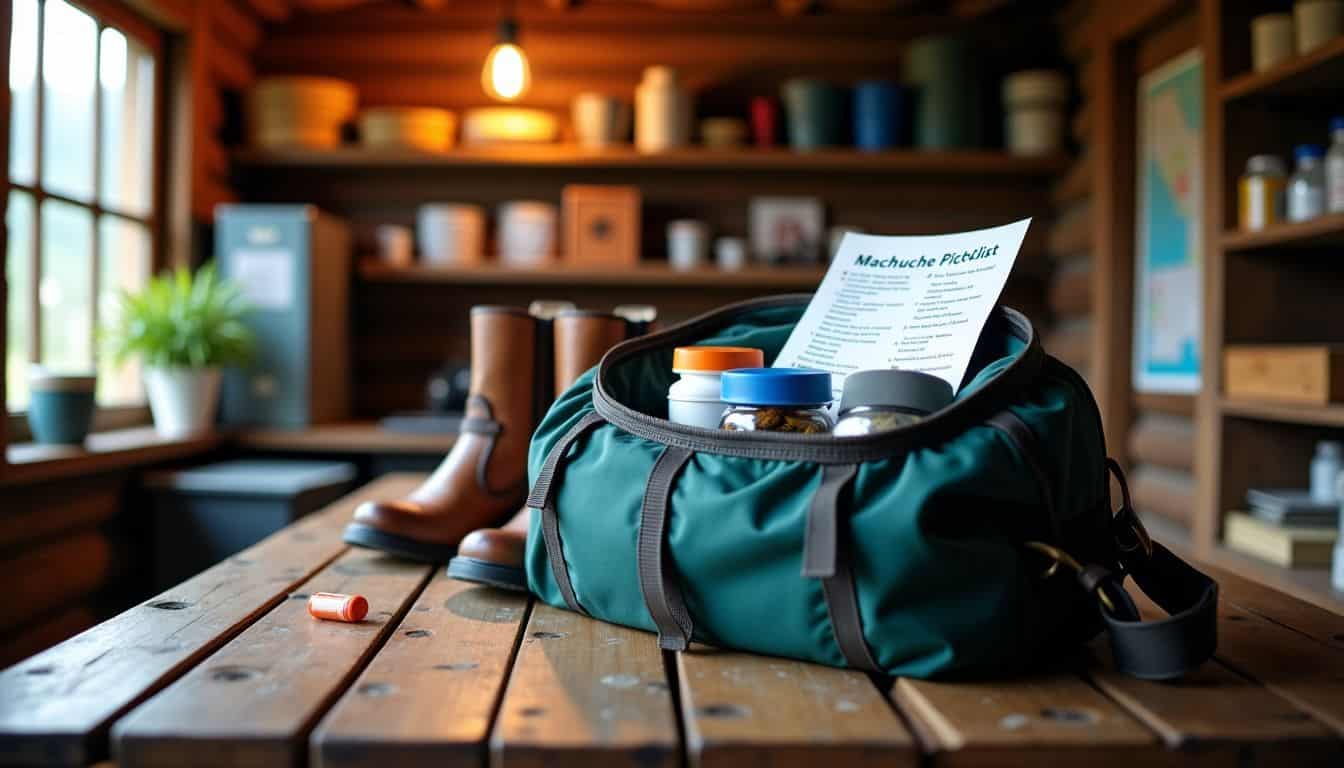
Pack smart for your Machu Picchu trek with a solid daypack filled with rain gear, hiking boots, and altitude sickness pills – click here to grab our full packing checklist that will make your Cusco adventure a breeze.
Essential Items to Bring
Smart packing makes your Machu Picchu trip easier and more fun. According to Tidbits of Experience, these items will help you explore the ancient Inca ruins with confidence.
- Daypack (15-20L): A small backpack holds your essentials while keeping your hands free to climb and take photos.
- Water Bottle: Bring a refillable bottle to stay hydrated at high altitudes. The site has no water stations.
- Rain Jacket: Weather changes fast in the Andes. A light, packable rain jacket saves you from sudden storms.
- Sun Protection: Bring sunscreen (SPF 50+), sunglasses, and a hat. The sun hits harder at 7,972 feet above sea level.
- Valid Passport: Guards check your passport against your ticket at the entrance. No entry without it.
- Cash in Soles: Many spots near Machu Picchu don’t take cards. Bring local money for food and extras.
- Insect Repellent: Bugs love the humid climate around the ruins. Strong repellent keeps them away.
- Hiking Shoes: Good grip helps you handle steep stone steps and slick trails safely.
- Camera: The views of the Inca Trail and ancient stonework deserve great photos.
- Snacks: Energy bars or trail mix help you keep going during long walks through the site.
- Basic First Aid: Band-aids, pain pills, and altitude sickness medicine come in handy.
- Portable Charger: Your phone or camera might run out of power during the long day of exploring.
Things to Leave Behind
Visiting Machu Picchu requires careful planning about what not to bring. The site has strict rules about prohibited items to protect its ancient stones and cultural significance.
- Large backpacks over 40L – Guards will stop you at the entrance. Bring a small daypack instead.
- Plastic bottles and containers – These harm the environment. Use metal or reusable containers for water and snacks.
- Drones or flying devices – The ruins need protection from aerial devices. Leave your drone at home.
- Tripods and professional camera gear – Regular cameras work fine. Special permits cost extra for pro equipment.
- Walking sticks with metal tips – These damage the ancient stones. Get rubber-tipped poles if needed.
- Food and snacks – Guards check bags for food. Eat at the restaurants near the entrance.
- Umbrellas – These block views for other visitors. Pack a light rain jacket instead.
- Smoking items – The site bans all smoking. Leave cigarettes and lighters at your hotel.
- High heels or dress shoes – The Inca trails need proper hiking boots. Fancy footwear ruins the paths.
- Musical instruments – The sacred site needs quiet. Keep instruments at your Cusco hotel.
- Selfie sticks – These annoy other visitors. Take photos without extra equipment.
- Sharp objects or weapons – Security checks all bags. Leave pocket knives at home.
Accessibility Considerations
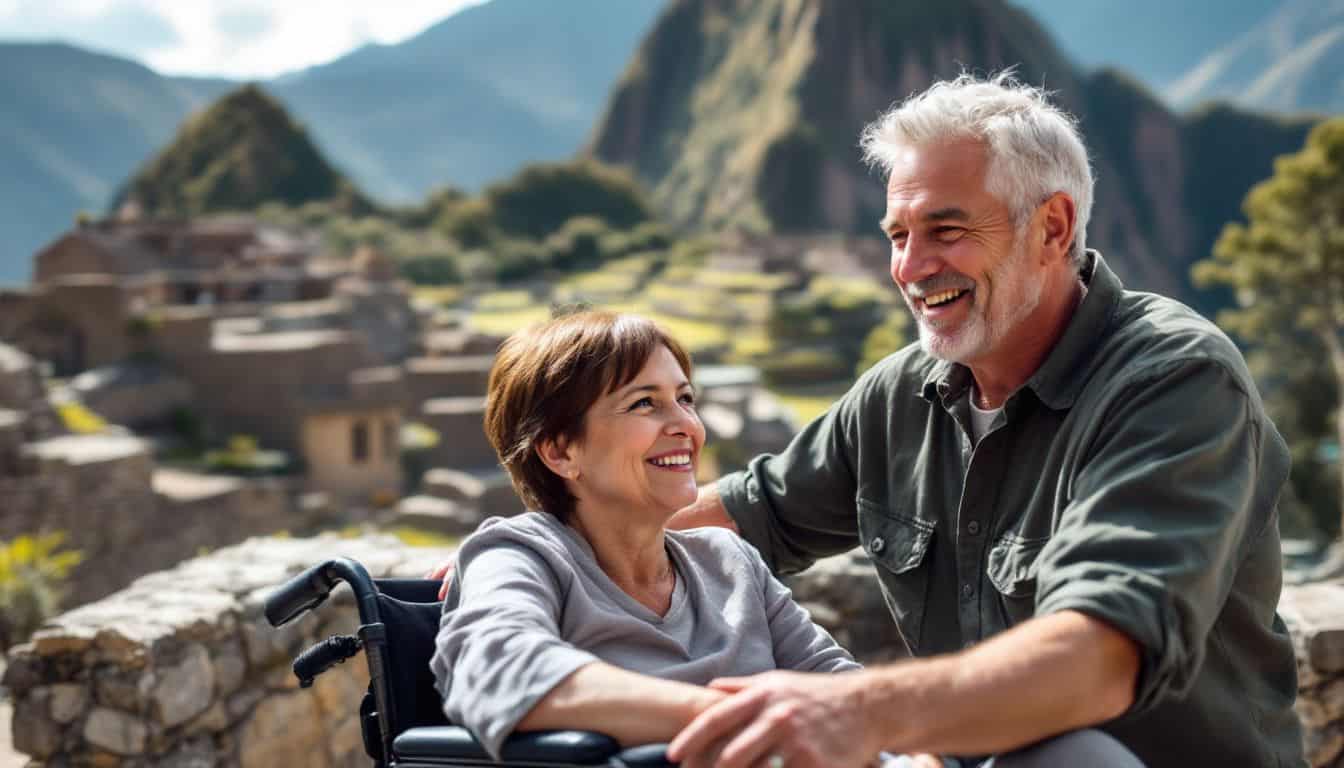
Machu Picchu offers special access options for visitors with mobility needs. Alpaca Expeditions leads the way with trained guides and modified equipment for different abilities. The site provides wheelchair-friendly buses from Aguas Calientes to the main entrance.
Tambo del Inca hotel stands out with its fully accessible rooms and facilities near the ancient city.
Early planning makes a big difference for a smooth trip to this Inca marvel. The trains to Cusco feature special cars with ramps and wider spaces. Most paths inside Machu Picchu have even surfaces, though some areas remain challenging.
Staff at the entrance can suggest the best routes based on mobility levels.
Tips for Adjusting to High Altitude

High altitude sickness hits hard in Cusco at 11,152 feet above sea level. Most visitors face headaches, nausea, and extreme tiredness during their first days. Smart travelers start their trip in the Sacred Valley at 9,000 feet to help their bodies adjust.
Coca tea works great to ease these symptoms, while alcohol makes them worse.
Your body needs extra water at high altitudes to fight off altitude problems. Pack a reusable water bottle and drink often throughout the day. Many hotels in Cusco offer free coca tea to guests – take advantage of this local remedy.
The next section covers key tips for being a responsible visitor to this ancient site.
Environmental Practices for Visitors

Machu Picchu needs your help to stay beautiful. The site bans plastic bottles and single-use items to protect its ancient stones. You must stick to marked paths during your visit. This rule keeps the ruins safe and helps rare plants grow.
I learned this firsthand during my trek – the guides make sure everyone follows the rules closely.
Pack a reusable water bottle for your visit to Cusco and the ruins. The clean mountain streams provide fresh water at filling stations throughout the site. Take all your trash with you when you leave.
The Inca Bridge and other spots have no garbage bins. These simple actions protect this amazing place for future visitors. The site’s rules against smoking also keep the air clean for everyone.
People Also Ask
When is the best time to visit Machu Picchu in 2025?
The best time to visit Cusco, Peru and Machu Picchu is during the dry season – from April to October. There’s less rainfall then, making it perfect for hiking and exploring the Inca Trail.
Do I need special permits to hike Machu Picchu?
Yes, you need hiking permits for Machu Picchu, Huayna Picchu (also called Wayna Picchu), and Huchuy Picchu. Book these early, as they sell out fast due to sustainable tourism rules.
What are the must-see spots at Machu Picchu?
Don’t miss the Intihuatana stone, the Inka Bridge, and Huchuy Qosqo. These spots show how amazing the old city of Vilcabamba was. The views from Mount Cook are also stunning.
How can I avoid overtourism at Machu Picchu?
Visit during early morning or late afternoon hours. Pick less busy months like April or November. You might also enjoy nearby spots like Colca or the cities of Cusco for a quieter experience.
What hiking options are there besides the main trail?
Besides the classic Inca Trail to Machu Picchu, you can try routes like the Kepler Track or Routeburn Track. These trails offer great alpine views with fewer crowds.
How long should I stay in Cusco before visiting Machu Picchu?
Stay in Cusco for 2–3 days to get used to the height. Visit local eateries and sites like Garcilaso while you adjust. This helps prevent altitude sickness when you head to Machupicchu.
References
https://www.salkantaytrekking.com/blog/the-best-time-to-visit-machu-picchu/ (2024-09-14)
https://www.machupicchu.org/planning-a-trip-to-machu-picchu-2025-essential-guide.htm
https://www.machupicchu.org/how-to-get-to-machu-picchu-without-hiking-2025-easy-guide.htm
https://www.machupicchu.org/fastest-way-to-get-to-machu-picchu-2025-complete-guide.htm
https://www.peru-explorer.com/hiking-machu-picchu-in-2025-the-best-routes-for-your-adventure.htm
https://www.adventure-life.com/peru/tours/347/classic-inca-trail
https://www.salkantaytrekking.com/
https://www.incatrailmachu.com/en/combo-expedition-choquequirao-to-machu-picchu-trek
https://www.muchbetteradventures.com/magazine/choquequirao-machu-picchu-trek-peru/ (2024-01-26)
https://www.perurail.com/tickets-to-machu-picchu/
https://www.ticketmachupicchu.com/availability-huayna-picchu/
https://www.machupicchu.org/train-to-machu-picchu-cost-2025-travel-guide.htm
https://www.peru-explorer.com/plan-your-2025-machu-picchu-trip-essential-tips.htm
https://www.salkantaytrekking.com/blog/where-to-stay-in-cusco/
https://www.insidehook.com/hotels/best-luxury-hotels-machu-picchu (2024-02-24)
https://www.comeseeperutours.com/travel-information/where-to-eat-in-machu-picchu
https://www.salkantaytrekking.com/blog/where-to-eat-in-cusco-2025-the-best-of-cusco/
https://www.machupicchu.org/machu-picchu-travel-info-guide-2025-plan-your-adventure.htm
https://www.paradisecatchers.com/inti-punku-sun-gate-at-machu-picchu/
https://www.incatrail.org/attractions/inti-punku
https://abexpeditions.com/inca-bridge-machu-picchu/
https://www.incatrailmachu.com/en/travel-blog/huayna-picchu-tickets-2019
https://www.machupicchu.org/explore-machu-picchu-circuit-2025-your-ultimate-guide.htm (2024-11-25)
https://meghanthetravelingteacher.com/machu-picchu-packing-list/
https://www.bigbravenomad.com/blog/what-to-pack-for-machu-picchu
https://www.incatrailmachu.com/en/travel-blog/machu-picchu-new-rules-2019

